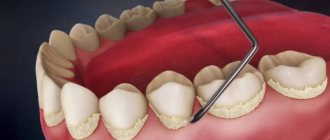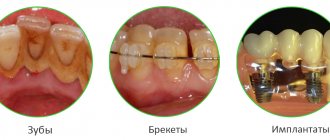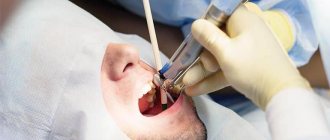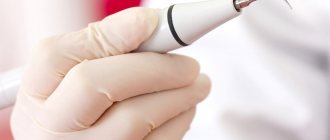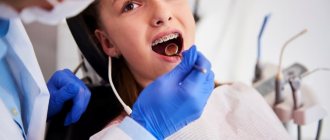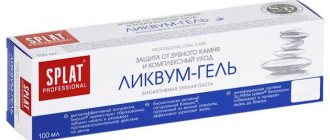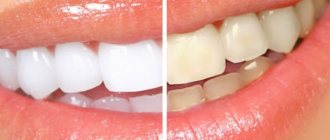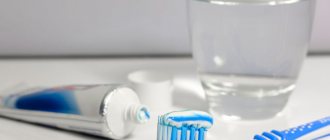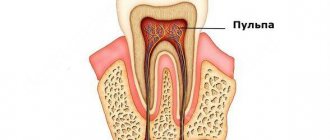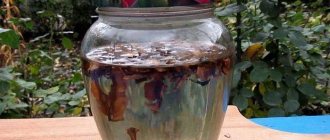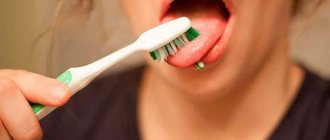Causes of tartar
Stone is a common problem; it forms in all people due to the peculiarities of the modern lifestyle. But the speed at which it appears is different for everyone. Hard plaque forms faster as a result of the following factors:
- insufficient oral hygiene;
- predominance of soft foods, sugar and fast carbohydrates in the diet;
- uneven chewing of food on each side of the jaw;
- excessive consumption of black tea and coffee;
- smoking;
- metabolic disease;
- saliva is too viscous.
How to remove plaque from a removable denture
Removable dentures, like your own teeth, require constant care and regular cleaning of plaque and food debris. Experts recommend cleaning the orthopedic device twice a day, and antiseptic treatment at least once a week. To do this, it is best to take baths with a special antibacterial solution, which can be purchased at any pharmacy. Traditional medicine offers its own version of cleaning the prosthesis:
- take white vinegar and mix it with water in equal proportions,
- place the prosthesis in a container with the resulting solution, leave the product there for several hours or even overnight,
- Remove the structure from the bath, carefully inspect it and, if there are any remaining stains, thoroughly clean them with a soft-bristled brush.
Vinegar diluted in water will help remove plaque from the prosthesis.
To maintain hygiene, it is also recommended to use an irrigator. This device does not replace a brush, but is an effective additional tool for keeping teeth and orthopedic systems clean.
How to detect tartar
You can do this at home in front of a mirror. Carefully examine your teeth from the outside and inside. The stone is located on the surface of the enamel and in the gum pockets. It is most pronounced on the inner side of the lower incisors. Tartar is divided into supragingival and subgingival.
Supragingival plaque is easier to detect; it covers the visible part of the enamel and has a yellow or brown tint. In a neglected state, it provokes the formation of caries. Signs of such a stone are bad breath, the appearance of pigment spots, and darkening of the enamel.
Subgingival plaque can only be detected by a doctor. This stone forms in the periodontal pocket—the area where the gum covers the tooth. The plaque has a dark brown or greenish-black tint. If neglected, it leads to the formation of periodontitis. This disease is dangerous due to the loss of healthy teeth. A distinctive sign of subgingival plaque is bleeding and increased sensitivity of the gums.
Symptoms signaling the formation of hard deposits
There are certain signs that indicate the beginning of the formation of tartar. It is important to know these symptoms so that you can recognize the problem in time and seek appropriate help. Here are the main ones:
- dark pigmented areas that first appear on the inside of the row, but gradually move to the front side,
- bad breath,
- redness or even blueness of the gums,
- the appearance of bleeding, especially during cleaning,
- inflammation of the mucous membrane, itching and soreness - in advanced cases, in the presence of subgingival deposits.
Bad breath may indicate a problem.
First, the stone forms at the neck of the tooth, surrounding it with a dark rim. Gradually it spreads into the subgingival area and covers an increasingly larger area of the coronal part.
Teeth cleaning from tartar in the clinic
In dentistry, to remove tartar, you can use the service of professional teeth cleaning (or professional oral hygiene). This service is available in almost all dental clinics. Several professional methods are used to remove tartar:
- Ultrasonic cleaning. This is the most accessible and widespread method. The doctor uses a special device - a scaler. It creates low-frequency vibrations that gently peel away hard deposits from the enamel. The doctor then uses water and air pressure to cleanse the mouth. Ultrasound is suitable for both supragingival and subgingival deposits. This method is safe for enamel and gums. At the end of the procedure, the dentist polishes and fluorides the teeth to reduce sensitivity and strengthen them.
- Laser cleaning. The procedure is similar to ultrasonic cleaning, the only difference is in the device used. Laser is considered a more modern method, effective and safe. The advantage of this method is that the laser promotes rapid gum regeneration and has an antibacterial effect.
- Air Flow. A modern way to clean the mouth. More expensive compared to the first two options. For cleaning, the doctor uses a pressure consisting of water, air and sodium carbonate. This method differs in that in addition to removing tartar, the enamel is also lightened.
There are also options for chemical and mechanical cleaning, but due to their traumatic nature and low efficiency, modern clinics do not use them.
Pastes for removing plaque and polishing teeth –
To remove small tartar and pigmented plaque, we can use 2 groups of products. Firstly, there are some whitening toothpastes that are highly abrasive. The second option is that you can purchase a special paste for polishing teeth in a specialized store that sells consumables for dental clinics (this option is much more effective, and you can even place an order online).
The advantage of the first option is the high availability of whitening toothpastes (list below), but their capabilities will be much more modest when compared with professional polishing paste for removing plaque and plaque. Below we will talk in more detail about each option.
Detartrine Z polishing paste –
Professional polishing pastes “Detartrin” and “Detartrin Z” do an excellent job not only of smoker’s pigment plaque, but also even of small dental deposits. The second version of this paste is especially effective, containing specially sharpened zirconium granules that can remove dental plaque and smoker’s plaque without damaging the enamel (24stoma.ru). In addition, the paste contains essential oils, leaving a long-lasting feeling of freshness in the mouth. Production – (France).
Pastes “Detartrine” and “Detartrine Z” –
The paste is taken from the tube only with a clean spatula and applied to the bristles of the working head of the Oral-b brush. Next, you need to “spread” the paste over several teeth, then turn the brush on at low speed, and treat each tooth for 10-20 seconds (more precisely, as needed). After treating your teeth, you need to rinse your mouth thoroughly several times. Use no more than once a week. The cost of a 45 mg tube of “Detartrine Z” in different stores can range from 1,600 to 2,800 rubles.
There is also another version of this paste - the usual “Detartrine” without zircon. It is a little cheaper, but also copes somewhat worse with, for example, the smoker’s residue. But in any case, both versions of this paste are much more effective at removing pigmented plaque and dental plaque than most other similar products (i.e. similar polishing pastes from other manufacturers).
Toothpaste “PRESIDENT PROFI PLUS White Plus” –
controlled abrasiveness – RDA 200 ,- abrasive and polishing components (silicon dioxide, calcium carbonate, diatomaceous earth, titanium dioxide),
- applied only once a week,
- price 30 ml - about 260 rubles.
It is necessary to apply a small amount of paste to a group of several teeth, and then use the Oral-b toothbrush at low speed, for example, in the “Whitening / Polishing” or “For Sensitive Teeth” modes. The effectiveness of PRESIDENT White Plus will be lower than Detartrine Z.
Toothpaste “LACALUT White” –
controlled abrasiveness – RDA 120 ,- abrasive and polishing components (hydrated silicon dioxide and titanium dioxide),
- benefits – contains pyrophosphates and sodium fluoride,
- fluoride content: 1357 ppm,
- together with an electric brush can be used once every 2 days,
- price: 50 ml – from 250 rub., 75 ml – 350 rub.
The effectiveness of this paste will be significantly lower than the previous ones. And she can only help you with a small amount of not too pronounced pigmentation. Apply according to the same principle as previous products (together with an Oral-B electric brush).
A few additional recommendations -
The cost of a good Oral-B electric brush starts from 2700-3500 rubles (at this link you can read our review on the optimal choice of models). You can even buy “Detartrine Z” or “Detartrine” polishing paste in traditional online stores, but it will be cheaper to do it in those organizations that sell consumables for dental clinics. There are many such companies in every city. And I would like to say a few more words about the selection of toothpaste for daily use in the morning and evening.
It is advisable that in patients with a high rate of tartar formation, such a paste contains polydon or pyrophosphates (these components significantly reduce the rate of mineralization of soft microbial plaque and its transformation into hard tartar). Polyphosphates (for example, sodium hexametaphosphate and trisodium phosphate) can significantly reduce the adhesion and deposition of microbial plaque.
Another useful components are the proteolytic enzymes bromelain and papain. They help loosen the already formed tightly attached microbial plaque, which certainly contributes to its removal by the abrasive components of toothpastes. In addition, it is desirable to contain sodium fluoride or amino fluoride in the paste, and in a concentration of at least 1400 ppm. The fact is that fluoride has a bactericidal effect, suppressing the vital activity of microorganisms, thereby preventing an increase in the volume of microbial plaque in the oral cavity.
Well, in the next section we gave several examples of techniques that are recommended for removing tartar at home - on various thematic sites and forums. You might be interested in reading this nonsense.
How to remove tartar at home
On the Internet you will find a dozen options for quickly removing tartar using available means: soda, hydrogen peroxide, vinegar, salt, herbal decoctions. We strongly do not recommend using any of them, because they are all ineffective and potentially dangerous. Why you can’t use home methods for removing tartar:
- When using soda and salt, abrasive particles damage the enamel.
- Solutions with vinegar and soda can damage the mucous membrane and cause burns.
- These methods are ineffective. For example, subgingival deposits can only be removed in the dentist's office.
- Herbal decoctions can stain the enamel, after which whitening will be required.
- Partial destruction of the enamel is possible.
- It is very easy to go overboard with the exposure time or dosage of these products.
How to remove stone in dentistry
The best way to combat plaque and deposits is professional cleaning. Today, as part of this procedure, dental clinics offer various techniques. Let's look at them in a little more detail:
- Air Flow sandblasting is a popular technique that is based on cleaning using a water-salt solution. It is supplied under high pressure and allows you to remove hardened deposits in hard-to-reach places. The smallest particles of the mixture literally beat off plaque and pigments from the enamel surface. For some time after the procedure, teeth may remain sensitive, especially to temperature changes in food and drinks. After cleansing, it is better to limit the consumption of coloring products, coffee, tea and smoking,
The photo shows the method of brushing teeth with the Air Flow system. - ultrasonic cleaning – under the influence of an ultrasonic scaler, the stone literally breaks down, turning into powder. Thanks to the simultaneous supply of water, the remaining plaque and hard deposits are easily and quickly washed away from the surface of the teeth. The technology allows for effective cleaning of gum pockets. The procedure is often performed in combination with Air Flow and is absolutely painless for the patient. After cleaning, the enamel is polished and coated with a fluorine-containing compound to further strengthen hard tissues,
Using the Vector ultrasound device, a specialist cleans periodontal pockets
“I am a regular client of your clinic, and I decided to express my gratitude with this review. I have treated your caries several times and for several years now I have been having my teeth cleaned here with Air Flow, at least once every six months. I really like the quality of service, the work of the staff and the atmosphere in general. Thanks to the efforts of your specialists, the procedure is always quick and absolutely painless. Your smile becomes snow-white, and no whitening is necessary! Personally, for me the effect lasts all these six months, until the next cleaning. True, I don’t smoke or drink coffee, I try to take care of my health...”
Marina A.K., Moscow, fragment of a review on the website of a dental clinic
- dry cleaning – special chemical reagents are also used to effectively break down hardened contaminants. Their help is resorted to in cases where ultrasound and sandblasting are ineffective. Hydrogen peroxide and compositions with abrasive particles are used as preparations.
The photo shows chemical teeth cleaning - Hand Cleaning – Hand tools can also be used to remove pigmented areas. These are small thin hooks with which the specialist “catches” the accumulations under the gums and carefully removes them from the pockets.
The manual method uses hooks for cleaning.
Gradually, hardened deposits will begin to destroy hard tissue, which can easily lead to caries. The microabrasion procedure will help stop this process. The essence of the technology is gentle polishing of the enamel surface, which carefully removes pigmented spots and prevents further development of the pathological process.
As part of the procedure, the specialist removes a very thin layer using a special abrasive composition. The layer thickness usually does not exceed 25-70 microns, so there is no need to worry about thinning of the enamel and its increased sensitivity. In complex clinical cases, up to 200 µm is sometimes removed1. The procedure is relevant for patients who have heavily contaminated and pigmented areas when they do not respond to the above cleansing methods. Indications for its treatment also include a spotted form of hypoplasia, caries at the “white spot” stage and signs of demineralization.
Prevention of tartar formation
Why do stones form on teeth? Primarily due to insufficient oral hygiene. Daily care should include brushing your teeth using a brush and toothpaste, mouthwash and dental floss. Carry out comprehensive cleaning twice a day: morning and evening. It is important to choose the right care products depending on the hardness of the brush, the composition of the paste and rinse aid, and the thickness of the thread. For example, a brush that is too hard can damage the enamel and mucous membranes, while a brush that is too soft will not clean plaque properly. You can choose hygiene products during a consultation with a dentist.
In addition to daily care, prevention also includes regular visits to the dentist. You must come for a routine examination and professional oral hygiene at least twice a year.
How to clean teeth from tartar? First of all, in the dentist's office. At home, you can only prevent stone formation through proper cleaning. The doctor will select the professional hygiene option depending on the condition of the teeth and gums and the patient’s personal preferences. Tartar cannot be ignored. Even if it does not bring noticeable discomfort, it is dangerous for the development of oral diseases, in particular, caries and periodontitis.
Alternative Methods
Peroxide is not always effective, so there are a number of alternative recipes that enhance its effect on tartar. Let's take a closer look at how to remove tartar using hydrogen peroxide and auxiliary components.
| Auxiliary Component | How to cook? | How to use? | Duration of use |
| Soda | Take a tablespoon, put half of the baking soda in it and add 3-4 drops of peroxide to make a plastic mass | Apply a large pea-sized amount of product to your toothbrush and clean your teeth thoroughly, paying special attention to chewing teeth. | 2 times a month |
| Oak bark | Grind 1 tablespoon of oak bark in a coffee grinder to a powder. Add a few drops of peroxide to make a thick paste | Apply the product to your toothbrush and go over all your teeth. This composition is especially good for gums, as it helps strengthen and destroy pathogenic flora. | 2-3 times a week, preferably at night |
| Sage and lemon | Grind a teaspoon of sage herb in a coffee grinder, add 5 drops of lemon juice and the same amount of peroxide | Apply the product to a cotton swab and apply it to your teeth, press lightly and hold for 3 minutes, then rinse your mouth with warm water. | 1 time per month |
Dozens of other ways to get rid of tartar are listed in our large selection.
Using peroxide, you can remove not only stones from teeth, but also from dentures. To do this, place the removable structure in a container with peroxide for several minutes, let it stand, and then clean it well with a stiff toothbrush. If you do this procedure several times a month, the dentures will be in perfect condition.
Note! Hydrogen peroxide cannot be used to replace regular hygienic toothpaste, as it will not give the desired effect. On the contrary, there is a risk of gums softening, which will lead to increased bleeding and premature receding.
We hope that our recommendations were useful, and now you know how to remove tartar with hydrogen peroxide. The procedure, you see, is not complicated, but precautions must be observed. If you doubt the effectiveness of the method, it is better to consult a specialist before using it. Perhaps peroxide specifically in your case will do more harm than good, and the stone will be removed using other methods.
Tags: at home, tartar, folk remedies, hydrogen peroxide, step-by-step instructions
About the author: DrZubastik
- Related Posts
- 9 Homemade Step-by-Step Recipes with Turmeric for Teeth Whitening
- How to whiten teeth at home quickly and effectively: 7 ways
- How to reduce tooth sensitivity at home?
« Previous entry
Preventive measures
The best prevention in this case would be a systematic visit to the dentist for professional cleaning. Experts in the field of dentistry and hygiene recommend undergoing the procedure at least once every six months. If the patient smokes or often drinks coffee and strong tea, prof. hygiene every 4 months, but on this matter you need to consult with your doctor - it all depends on the current condition of the enamel and its individual characteristics.
Proper dental hygiene is important to maintain your smile.
As mentioned above, you should periodically use an ultrasonic or electric brush, as well as a special abrasive paste with an RDA index above 1202 - this indicator will be indicated on the packaging. Just remember that you cannot constantly use such a product, as it can harm the enamel layer. It is better to alternate it with fluoride-containing and regular prophylactic paste. You also need to remember to use floss, rinse your mouth every time after eating, and it is better to purchase an irrigator to clean the interdental spaces and hard-to-reach places. It is recommended to consume hard vegetables and fruits more often - the moment you bite into an apple or, for example, a carrot, natural plaque is removed from the enamel
Precautionary measures
Using any home method for removing tartar requires:
- Consultations with a specialist. This will help avoid negative consequences and reduce the risk of harm to the body.
- Avoid using a toothbrush or use only soft bristles.
- Brushing your teeth with a toothpaste high in fluoride and calcium.
- Do not allow the mixture to come into contact with the gums and other mucous membranes.
- Do not exceed the exposure time of soda to the enamel.
How does soda work?
Soda powder has a fine-grained structure, due to which it gently cleanses and destroys tartar. Thanks to its alkaline effect, sodium bicarbonate changes the chemical nature of solid deposits, and due to its abrasive properties, it removes them layer by layer.
On a note. Some professional dental cleaning powders contain from 20 to 50% baking soda.
In addition, sodium bicarbonate improves the condition of the oral cavity:
- Increases the pH of saliva, neutralizing the aggressive effects of organic acids on teeth.
- Gently polishes the enamel, giving it a lighter tone.
- Prevents the formation of plaque, which increases the absorption of minerals from saliva by dental tissue.
Subtleties of use
The amount of mixture used, as well as the frequency of use, will depend on its components. Typically, a pea-sized amount of paste is used to brush your teeth.
Regularity. Some formulations can be used every day, more aggressive ones - no more than 1-2 times a month.
The use of soda may result in thinning of the enamel, as well as deterioration in the mineralization of teeth, which can lead to an increase in their fragility. Therefore, during the treatment period you should:
- use toothpaste with a high content of calcium and fluoride;
- increase the amount of dairy products in the diet (an additional source of calcium).
Reviews
Christina. I really like drinking coffee. Because of this, pigmented plaque appears on the teeth. I started brushing my teeth with dry soda powder every day for 1.5 weeks. The result is positive: the teeth are lightened and the plaque is gone. No sensitivity was evident.
Natalia. I used activated carbon. There is an effect, but it is insignificant. I haven’t observed any negative effects, so I use it sometimes.
Olga. I brushed my teeth with baking soda for 2 weeks in a row. The plaque has partially disappeared, but the stones remain in place, and the enamel is still yellow. I don't recommend it.
Vladimir. After using baking soda with lemon, severe tooth sensitivity appeared. Now I can’t eat anything cold or sour. I don’t recommend it to anyone, it’s better to go to the dentist.
The best product for cleaning dentures
Most patients first of all want to know not how to clean dentures, but what is the best way to do it. Regular hygienic toothpaste is suitable for cleaning. It should not contain abrasive components that can scratch the surface of the structure. After scratches form on it, plaque will accumulate in them.
Tooth powder is not suitable for cleaning dentures. The best choice for this purpose is baby toothpaste. It is not recommended to use soda and dishwashing liquid, as these products can worsen the appearance of the prosthesis.
Comments from dentists
Dentists do not recommend the use of sodium bicarbonate in the fight against tartar.
Valery Leontiev, dentist, member of the Russian Dental Association. Tartar adheres firmly to the tooth tissue, so it must be removed only by special methods from a professional. Baking soda can only remove mild plaque from teeth. By self-medicating, you can damage tooth enamel.
Victor Vasiliev, dentist, director of the dental clinic. The use of soda is ineffective in the fight against hard dental plaque, especially subgingival plaque. Despite the fact that it is part of professional teeth cleaning products, it is worth remembering: in dentistry, in addition to powdered products, special devices and instruments are also used. This medical procedure cannot be repeated at home.
